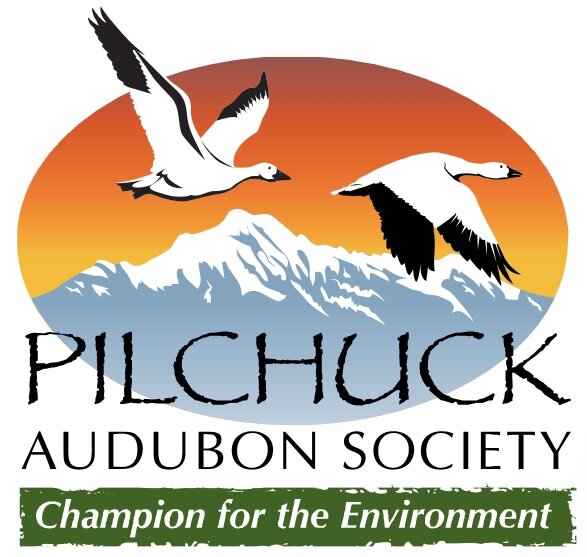Photo: Common Yellowthroat by Eastside Audubon Society
By Martha Jordan (Pilchuck Audubon) and Jeremey Lucas (Eastside Audubon)
Likely you have driven by the Cherry Valley Unit wildlife area on your way to and from destinations north and south of Duvall along State Highway 203. If you have not yet stopped by to take a look at the diverse habitat, now is a good time to do so. Although hunting season will be starting on September 1st, there is still plenty of area to go birding and just enjoy a walk through this diverse wildlife area.
The Cherry Valley Unit is 386 acres located in King County about one mile north of Duvall with access from Highway 203. It is a mix of forest, grassland, and wetland in the Snoqualmie River floodplain. The unit is located at one of the lowest points in the Snoqualmie River valley, so flooding is common from mid-November through April. The unit was acquired primarily for hunting pheasant and dog training along with the wetland value. The department has implemented projects to restore salmon populations in the two creeks that flow through the unit.
A large parking area just off Hwy 203. There are no restrooms or other amenities. This Unit, just like all the other units, are closed during hours of darkness including the parking lot.
Recreation opportunities include pheasant and waterfowl hunting, hunt dog training, and wildlife and bird viewing. It is also great for just taking a walk in the outdoors. Please note that this unit is popular for pheasant and waterfowl hunting in the fall and winter, and dog training and hunting dog trials in the spring and summer. It is a shared space; please be respectful of the various users who may also be on the site. There are areas of this unit that are available for wildlife viewing that is closed to hunting and/or dog training. If you do go out during hunting season, we strongly suggest you wear an orange or pink vest or hat for visibility.
Wildlife Viewing
This unit includes deciduous and coniferous forest, uplands, grassland/meadows, streams, wetlands cultivated farm fields and hedgerows, offering opportunities to view a variety of wildlife, including waterfowl, raptors, songbirds and a variety of large and small mammals. A vision for this unit includes expanding agriculture to improve waterfowl habitat and wetland enhancement.
Search for what others have seen recently and in the past at Cherry Valley Unit by clicking on this eBird link: https://ebird.org/hotspot/L5284521/media?yr=all&m. This is a citizen science database portal that provides freely-shared bird lists at 'hotspots' and interactive maps plus other birding information updated daily. The eBird information shows a checklist with seasonal information on the 115 species of birds reported from this Unit
Special Habitats & Species
The unit is located in critical salmon priority habitats, particularly for chinook salmon and steelhead. The department has implemented projects to restore salmon populations in the two creeks that flow through the unit. While salmon is one focus, Cherry Valley has an abundance of bird species, including hawks, owls, swans, geese, waterfowl, and songbirds. Deer, coyote, beaver, and river otter, and recently elk, are among the larger mammals on the unit.
For information on other Snoqualmie Wildlife Units and for all WDFW Wildlife Areas around Washington please visit: https://wdfw.wa.gov/places-to-go/wildlife-areas
A BIRDING WITH AWARENESS REMINDER:
BEFORE YOU GET OUT OF YOUR VEHICLE: Please remember to put your Discover Pass on your dashboard or hang it on the rearview mirror. You need a Discover Pass to park in any WDFW Wildlife Area parking lot or their boat access sites. They can be purchased anywhere WDFW licenses are sold and online.
Read what is posted on the reader boards/kiosks.
Note if there are other cars in the lot. Be aware that other activities may be happening on the unit such as hunting (big game, waterfowl and upland bird) during certain dates, hunt dog training, or a scheduled special activity. A reminder that during the fall these areas are pheasant release sites for hunting and special hours may apply on pheasant release days.
If you are out during hunting season it is suggested that you wear an orange or bright pink vest, so hunters can see you.
If you see a wildlife-related issue, including poaching, there are several ways you can report the issue:
Call 911 to report poaching in progress, a dangerous wildlife complaint, or an emergency.
Call 877-933-9847 for non-emergency poaching/violation reports.
Send an email to reportpoaching@dfw.wa.gov.
Send a text tip to 847411 (TIP411) by entering WDFWTIP, followed by a space, and then entering your report.
Use the online form to report a violation
And remember, please keep your dog on leash at all times while out enjoying your wildlife viewing. Our wildlife areas are not off-leash dog parks.
If you are able and willing, bring a garbage bag and either some collection device (like a stick) or gloves, please do so. Picking up the smaller items is appreciated, especially when out on the unit. The bigger items as well as most of the garbage piles dumped at the parking lots are picked up by volunteers associated with other groups, especially the hunting groups. I keep a hiking checklist and those items are always included in my run-through of everything I need.
REPORT garbage dumping, serious graffiti, damage to signs or kiosks, and damage to the parking lot by sending an email to the Snoqualmie Wildlife Area manager at brian.boehm@dfw.wa.gov. Or you can call Martha Jordan, a member of the Snoqualmie Wildlife Area Citizen’s Advisory Committee at 206-713-3684.
With some knowledge about the shared space, regulations, and what you can do to be part of the active stewardship community, you can not only help protect these areas for wildlife and future generations but have a great and safe time out there. Now, get out there and bird!


